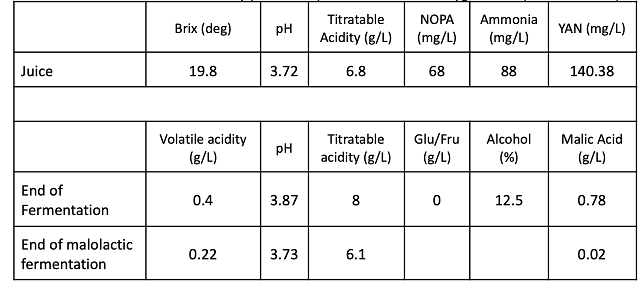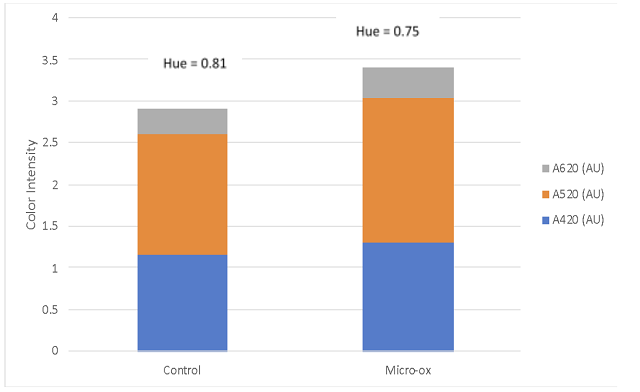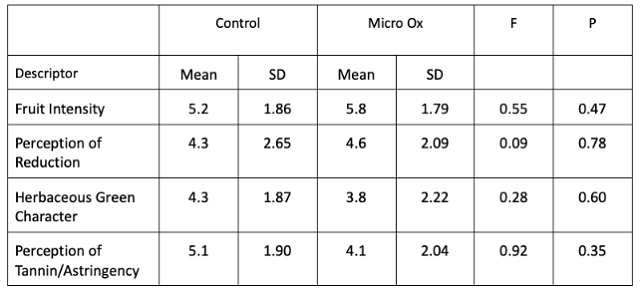Effect of Micro-oxygenation on Cabernet Sauvignon (2020)
Michael Heny
Michael Shaps Wineworks
Summary
Micro-oxygenation (MOX) is the process of intentionally adding small amounts of oxygen in a measured way to induce favorable changes in color, aroma, and texture1 in wine. One of the most common reasons to micro-oxygenate wine is to help structure tannins and fix color, but it can also be used to treat reduction. In this experiment, a Cabernet Sauvignon wine with reductive aromas and grippy tannins was treated post-malolactic fermentation with 3 mL/min of oxygen for 7 hours every other day for two weeks. A control lot received no micro-oxygenation. There were no large differences in wine chemistry and no significant differences in sensory characteristics with this dosing regime.
Introduction
Winemakers have a complicated relationship with oxygen. At times, fiercely protecting juice and wine from its presence, excluding it in any way possible. At other times, inviting it in and hoping it does its work. It all depends on the wine, and the situation. There are several steps during the winemaking process when oxygen is introduced into juice and wine, including crushing, pressing, racking, aging and bottling. After introduction to the wine, oxygen is quickly bound by various components of the wine including ethanol (to form acetaldehyde), phenolics (tannins and anthocyanins), SO2, aroma and flavor compounds, and can have a profound effect on astringency and aroma.
Unlike the uncontrolled addition of oxygen during cellar operations, micro-oxygenation (MOX) is the process of intentionally adding small amounts of oxygen in a measured way to induce favorable changes in color, aroma, and texture1. The technique was first developed in France in the 1990’s as a way of aging of tannic red wines in stainless steel tanks rather than oak barrels. It is now also used to accelerate aging, stabilize color, and treat reduction and herbaceous/green character. Rather than shortening the life of a wine, as oxidation normally does, MOX can increase the anti-oxidative power and potential aging of the wine by stimulating phenolic reactivity2.
One of the most common reasons to micro-oxygenate wine is to help structure tannins and fix color. Micro-oxygenation soon after fermentation is thought to bind anthocyanins to growing tannin chains before they are lost to precipitation, enzymatic attack or binding to lees, resulting in better color retention and shorter tannin polymers2,3. Polymeric pigments (tannin polymers capped with anthocyanins) are less susceptible to oxidation and browning than monomeric anthocyanins, so MOX also aids in color stability by preserving anthocyanins in solution in their colored form4. A fuller description of these reactions can be found in the Learn section of the WRE website.
In addition to color stability and tannin structure, micro-oxygenation also has an effect on the perception of reduced compounds such as H2S (sewer gas, rotten eggs) and methyl mercaptan (cabbage, skunk). Reduction is the chemical state of a compound whereby it has gained electrons in a reaction. Hydrogen atoms only hold their electrons weakly, so when they are bonded to sulfur atoms, the electrons spend more time near the sulfur, resulting in a reduced sulfur compound. Oxygen atoms on the other hand are strong electron attracters, so when oxygen is added to a solution with reduced sulfur compounds, some of the electrons will be attracted to the oxygen atoms and leave the sulfur atom, thereby oxidizing the compound. Oxidation of hydrogen sulfide results in two odorless compounds (water and elemental sulfur). Oxidation of methyl mercaptan results in dimethyl sulfide, which still has off odors of onion and garlic, but at a higher threshold of detection (12 ppb vs. 0.2-2 ppb)2,5.
Despite its potential benefits, micro-oxygenation has some risks. Allowing micro-oxygenation to go on too long can lead to excessive polymerization, making tannins dry and harsh5. Oxygenation at too high of a rate can cut off the chain reaction of polymerization by starting too many chains at once. Ultimately this leaves excess oxygen in the wine that reacts with anthocyanins to cause browning as well as varietal aromas and flavors, causing oxidative off odors6. Oxygen availability in wine can also lead to microbial spoilage. Acetobacter will use available oxygen to produce acetic acid. Brettanomyces growth is facilitated by the presence of oxygen5 (though it is thought that at low levels, micro-oxygenation poses less of a threat than standard racking1).
Bruce Zoecklein2 likens the management of micro-oxygenation to piloting an ocean liner. It must be done carefully and pro-actively with the understanding that one action begets a chain reaction that is not easy to control or fully predict. A firm understanding of the underlying mechanisms at play and careful monitoring of progress are key to success. The purpose of this experiment was to determine the chemical and sensory effects of post-malolactic micro-oxygenation of a light bodied Cabernet Sauvignon with reductive aromas and grippy tannins.
Methods
Cabernet Sauvignon grapes were harvested on 10/22/20, chilled overnight then destemmed and lightly crushed to tank and TBins with the addition of SO2, Lafase XL enzyme (0.05 mL/L), Nadalie AMT+ chips (1.4 kg/ton) and a mix of Tanin VR Color and Tannin VR Supra (for a total of 0.25 g/L). Must was inoculated the next day with 0.2 g/L D254 yeast rehydrated in 0.15 g/L GoFerm. Must was pumped over (tank) or punched down (TBins) twice daily during active fermentation. Sugar (32 g/L), tartaric acid (1.0 g/L), and nutrients (0.7 g/L Superfood, 0.22 g/L DAP) were added on 10/27, at the beginning of log phase. Wine was pressed on 11/3 with Tbins and tank fermentations combined. Wine was racked to two identical 2100L tanks on 11/10, one control and one designated for micro-oxygenation. Malic acid was measured as <0.05 g/L on 11/16 and the treatment tank had turbidity of 119 NTU. An additional 1.0 g/L tartaric acid was added prior to the beginning of micro-oxygenation.
Lead lines from the Stavin Ox Box were threaded into the treatment tank so that dosing stones were suspended 1 inch from the bottom of the tank (to avoid lees). Lines remained in place for the duration of the experiment to avoid oxygen addition from disturbing the surface. Continuous dosing was not possible from the Ox Box due to the height/volume of the tank and the lower limit of oxygen flow allowed by the box. Instead, a discontinuous rate was set at a dose rate of 3 mL/min for 7 hours every other day. Throughout the experiment, both lots were monitored weekly for sensory attributes. The treatment lot was micro-oxygenated on 11/16, 11/18, 11/20, 11/23, 11/25, 11/30, 12/2 and 12/4. The control lot received no oxygen treatment. Wine was treated with 50 ppm SO2 and transferred to barrel on 12/11. Wine chemistry was sampled on 12/17, after the first SO2 dose had been made.
Sensory analysis was completed by a panel of 20 wine producers. Due to restrictions put in place during COVID-19, sensory analysis was completed using shipped samples. Each wine producer received three wines in identical bottles, filled on the same day, each coded with random numbers. Two of the bottles contained the same wine while the third bottle contained the different wine. Participants were asked to identify which wine was different (a triangle test). There were four tasting groups with the unique wine in the triangle test balanced among the groups. Participants were then asked to score each wine on a scale of 0 to 10 for fruit intensity, fruit character, perception of reduction, herbaceous/green character, and perception of tannin/astringency. They were also given open ended questions to describe the wines. Results for the triangle test were analyzed using a one-tailed Z test. Descriptive scores were analyzed using repeated measures ANOVA.
Results
Wine completed fermentation without difficulty. Juice and wine chemistry throughout fermentation can be found in Table 1. As expected, micro-oxygenation did not cause a large change in wine chemistry (Table 2). The micro-oxygenated lot had slightly higher color intensity (Figure 1) with little difference in measurable phenolics (Table 3). However, these tests measure quantity of tannins, not quality.
In a triangle test of micro oxygenated wines, 9 out of 20 respondents were able to distinguish which wine was different, indicating the wines (were not) significantly different (Z=0.87, p= 0.19). There were also no significant differences in scores for fruit intensity, perception of reduction, herbaceous green character or perception of tannin/astringency (Table 4). Microoxygenation at this rate and under these circumstances had no measurable effects.
Table 1: Juice and wine chemistry prior to separation for micro-oxygenation (in-house data)

Table 2: Wine chemistry for two treatments of Cabernet Sauvignon (ICV labs, December)

Figure 1: Color intensity for two treatments of Cabernet Sauvignon (ICV labs)

Table 3: Phenolic analysis for two treatments of Cabernet Sauvignon (mg/L) (ETS labs)

Table 4: Statistical analysis of descriptive scores from blind sensory analysis of Cabernet Sauvignon

References
(1) Gómez-Plaza, E.; Cano-López, M. A Review on Micro-Oxygenation of Red Wines: Claims, Benefits and the Underlying Chemistry. Food Chemistry 2011, 125 (4), 1131–1140.
(2) Zoecklein, B. W. Winemaking Topics; Micro-Oxygenation. Virginia Tech Wine/Enology Grape Chemistry Group, n.d.
(3) Smith, C. Postmodern Winemaking: Rethinking the Modern Science of an Ancient Craft by Clark Smith (7-Jan-2014) Hardcover; University of California Press, 2014.
(4) Waterhouse, A. L.; Laurie, V. F. Oxidation of Wine Phenolics: A Critical Evaluation and Hypotheses. American Journal of Enology and Viticulture 2006, 57 (3), 306–313.
(5) Zoecklein, B. W. Current Theory and Applications: Microoxygenation. Practical Winery and Vineyard 2007, November/December.
(6) Singleton, V. L. Oxygen with Phenols and Related Reactions in Musts, Wines, and Model Systems: Observations and Practical Implications. 1987, 38 (1), 69–77.
